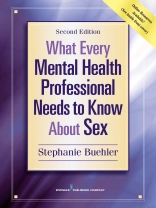The second edition of this acclaimed guide to understanding sexuality and working with clients on sexuality issues is extensively updated to reflect recent scientific, practical, and social developments in the field. It provides updated information on relevant disorders in the DSM-5, new theoretical approaches, new pharmacological treatments, updated information on STDs, new understandings of transgender individuals, the impact of same-sex marriage laws, controversies over sex addiction, and much more. Chapters are enhanced with the addition of new take-away points, additional worksheets, and a glossary.
Distinguished by an easy-to-read, down-to-earth approach, the text provides plentiful information, tools, and exercises to increase the confidence and comfort of both trainee and experienced mental health professionals treating sexual issues. Based on the premise that the therapist must be comfortable with his or her own sexuality in order to provide effective treatment, the book discusses the characteristics of healthy sexuality for both client and therapist and addresses issues of discomfort that may arise for the therapist.
New to the Second Edition:
- Sexual and other disorders in DSM-5
- New understandings of sexual identity and fluidity, including transgender
- Legal status of same-sex marriage
- New pharmacological treatments for sexual issues
- New methods of sexological research
- Updated and expanded coverage of assessment tools
- Mindfulness interventions
- Supplemental Instructor’s Manual with quizzes and chapter-by-chapter Power Point slides
- Updated Practitioner Resources including informational handouts and illustrations
Tabla de materias
Contents
Foreword by Paul Joannides, Psy D
Preface
Part I: The Courage to Treat Sexual Problems
1. Sexuality and the Mental Health Profession
Why the silence about sexuality?
Take-away points
Activities
Resources
References
2. Making the Shift: Comfort With Sexuality
Stage 1: self-examination
Stage 2: sex from the client’s point of view
Stage 3: freedom and comfort in talking about sex
Stage 4: a new level of comfort with clients’ issues
Supervision and consultation
Take-away points
Activities
Resources
References
3. Sexual Anatomy and Psychosexual Development
Sexual anatomy
Sexual development
Take-away points
Activities
Resources
References
Kegels for everyone
4. Evolution of the Field of Sexology and Sexual Health Definitions
Historical view of sexual health
Scholarly definitions of sexual health
Risks to sexual health
Relational factors and sexual health
The sexuality of the therapist
Take-away points
Activities
Resources
References
Declaration of sexual rights
How to use a condom consistently and correctly
Part II: Assessing and Treating Sexual Concerns
5. Assessing Sexual Problems
Sexological microsystem
Sexological mesosystem
Sexological exosystem
Sexological macrosystem
Sexological chronosystem
The sexological ecosystemic assessment
The sexual genogram
Take-away points
Activities
Resources
References
Sexological ecosystemic questionnaire
6. Women’s Sexual Health Problems
Female sexual interest/arousal disorder
Losing one’s natural drive: low interest in sex
Female orgasmic disorder
Sexual disgust: A problem with no diagnosis
Take-away points
Activities
Resources
References
Sensate focus activities
Experiencing orgasm
7. Men’s Sexual Health Problems
Socialization and male sexuality
Erectile disorder
Improving erectile function and sexual confidence
The problem of ejaculating quickly
Developing ejaculatory control
When ejaculation is delayed
Male hypoactive sexual desire disorder
Treating low desire in men
Take-away points
Activities
Resources
References
Tips for better erections
Tips for lasting longer
8. Relationships and Sex Therapy
Factors that contribute to sexual dissatisfaction
Take-away points
Activities
Resources
References
Talking to each other about sex
Sex, love, and contraception
A trip to the sex toy shop
I like/I don’t like…
9. Parents’ Questions About Sex
When to start talking about sex
Answering parents’ common questions
Take-away points
Activities
Resources
References
Talking to your children about sex
Talking about sexual values
10. Therapy With Sexual Minorities
Understanding sexual orientation
Avoiding bias
Asexuality
The transgender experience
Sexual behavior in the LGBTQ population
Treating sexual problems in LGBTQ clients
Take-away points
Activities
Resources
References
Preparing for anal sex
11. Sexuality and Mental Health Problems
Assessing sexual problems caused by mental illness
Depressive and bipolar disorders
Anxiety and obsessive-compulsive disorders
Trauma-related disorders
Feeding and eating disorders
Substance-related disorders
Neurodevelopmental disorders
Somatic disorders
Personality disorders
Sexual side effects of antidepressant and antipsychotic drugs
Management strategies
Other drugs that can cause sexual problems
Take-away points
Activities
Resources
References
When a partner is mentally ill: relationship tips
12. Sexual Recovery in Trauma Survivors
Posttraumatic stress disorder versus complex trauma
Complex trauma in survivors of childhood sexual abuse
Treating sexual problems in adult survivors of abuse
Military sexual trauma
Novel approaches to treating trauma
Addressing specific sexual dysfunctions
A final word to therapists about treating survivors
Take-away points
Activities
Resources
References
Mindfulness and sexuality
Understanding sexual triggers
13. Healing Painful Sex
Understanding pain
Assessment of sexual pain disorders
The psychological fallout of painful sex
Types of sexual pain disorders in women
Treatment of female sexual pain disorders
Types of sexual pain disorders in men
Mental health in the treatment of men’s sexual pain disorders
A word about integrated care
Take-away points
Activities
Resources
References
Understanding pain management
Outercourse
14. Sexuality and Reproduction
Infertility
Sexual dysfunction and infertility
Effect on the couple’s intimacy
Assessment and treatment of infertility-related sexual problems
Sexuality, pregnancy, and the postpartum period
Treatment of sexual problems related to pregnancy and childbirth
Take-away points
Activities
Resources
References
Sex after baby
15. Sexuality and Medical Problems
Effects of illness on relationships and sexuality
Cancer
Chronic fatigue syndrome and fibromyalgia
Diabetes mellitus
Neurological disorders
Skin disorders
Assessment
Treatment
Take-away points
Activities
Resources
References
Preparing to engage in sexual activity
Tips for coping with chronic illness or cancer together
16. Sexually Transmitted Infections
Bacterial vaginosis
Chlamydia
Genital herpes
Gonorrhea
HIV/AIDS
Human papillomavirus
Syphilis
Talking to couples and sexually active individuals about STIs
Take-away points
Activities
Resources
References
Preventing STIs
17. Sexuality and Aging
Myths about sexuality in older adults
Understanding obstacles to sexual activity as we age
Assessment of sexual problems in aging adults
Take-away points
Activities
Resources
References
Enjoying sex as a mature adult
18. Alternative Sexual Practices
Alt sex practices in therapy
Who practices alt sex—and why?
Assessment and treatment of alt sex practices
Take-away points
Activities
Resources
References
19. Out-of-Control Sexual Behavior
Historical view
Assessment of OCSB
Treatment of OCSB
Take-away points
Activities
Resource
References
Dealing with OCSB
Part III: Ethics and Practice of Sex Therapy
20. Ethical Management of Sex Therapy Casework
Maintaining appropriate boundaries
Transference and countertransference of attraction
Objectivity around issues of sexuality
Sexual medicine: blessing or curse?
Managing secrets in conjoint therapy
Take-away points
Activities
Resources
References
21. Sex Therapy: Now and in the Future
Problems in the field
The practice of sex therapy
Marketing yourself as a sex therapist
Continuing education
In closing
Take-away points
Resources
References
Index
Sobre el autor
Stephanie Buehler, Psy D, CST-S, is a licensed psychologist and AASECT-Certified Sex Therapist and Supervisor. She is the director of The Buehler Institute and Learn Sex Therapy.com which offers continuing education in sexuality for mental health and wellness providers.












